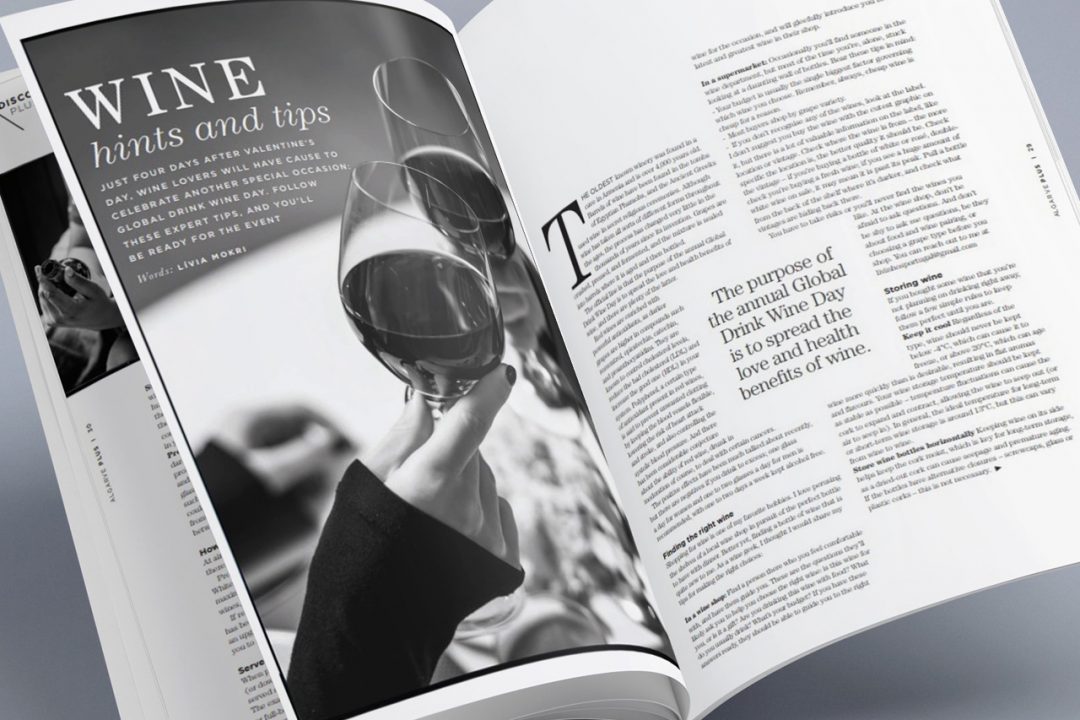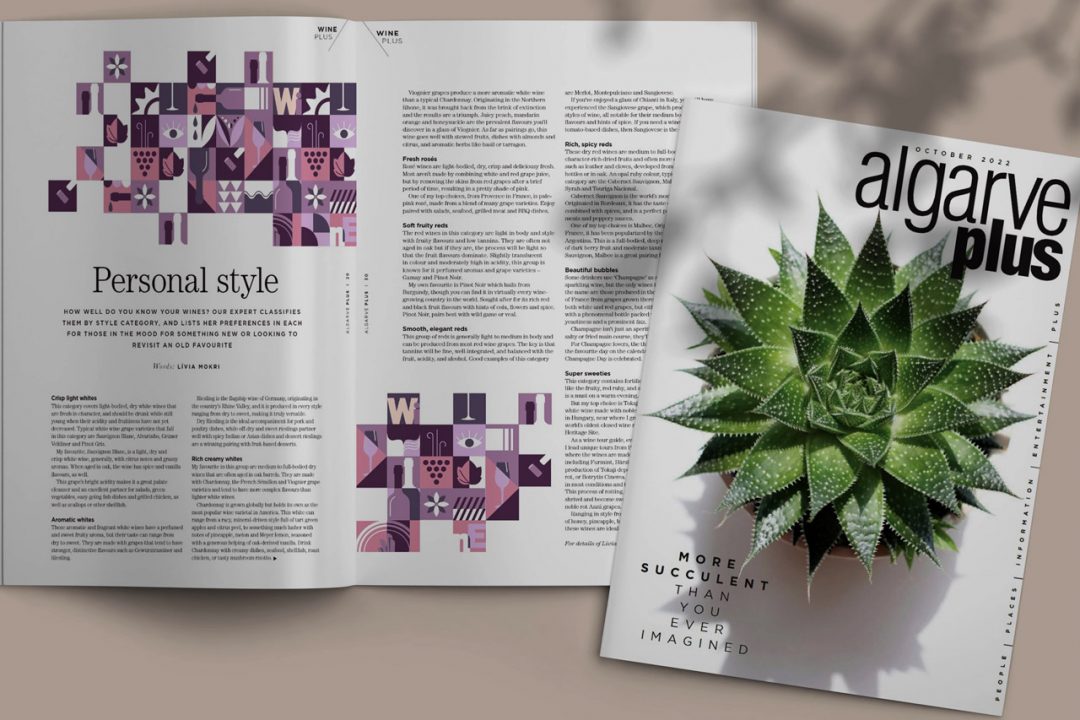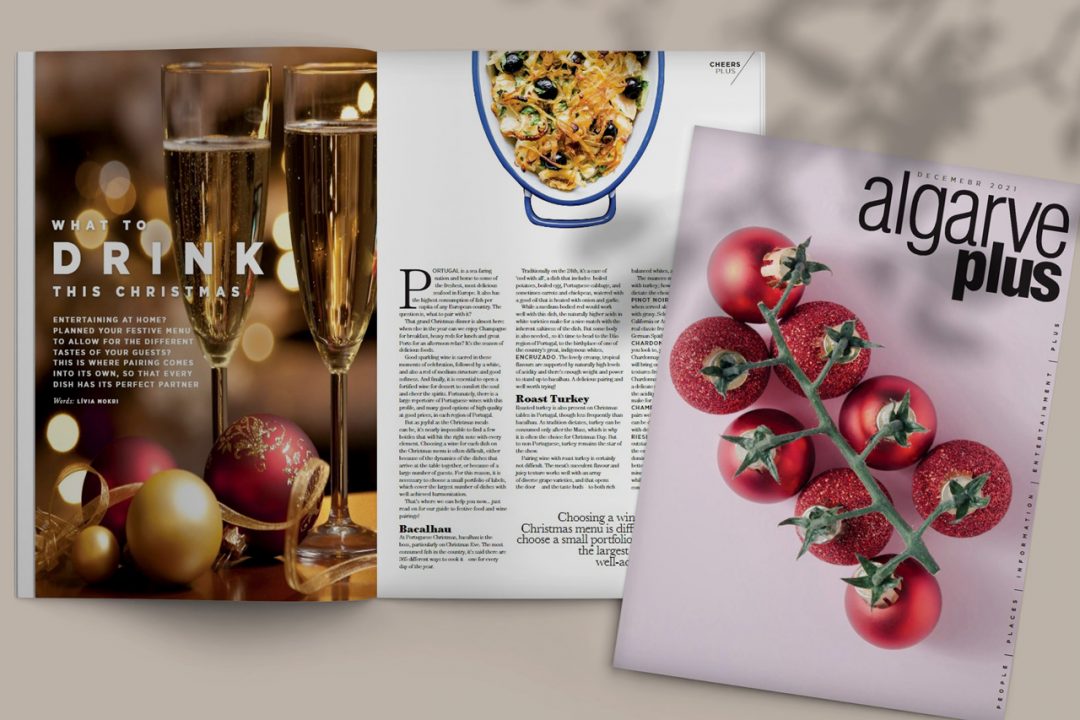Wine hints & tips – Did you know that we celebrate Global Drink Wine Day on the 18th of February? Another special occasion to raise our glasses.
But do you know how to find the right wine in a shop? How to store and open a bottle? Or how to serve this amazing drink? And even, how to taste wine like a Pro?
Yes or no, just read my new article in the February issue of the Algarve Plus Magazine, and you will be ready for the event!
I am happy to share that the June issue of the Algarve Plus Magazine has already been published, with my new article!
The magazine is readable online or downloaded for free here.
Enjoy!
Or read here the whole article:
Wine hints & tips
Let’s be honest, there are many days when we are pretty sure that is just a usual day. But not on the 18th of February. Because of that day, we celebrate Global Drink Wine Day.
The actual origins of this particular day seem to be unknown. But what is sure, is that the wine needs to be celebrated and the Global Drink Wine Day is celebrated each year on February 18 around the world.
It’s amazing to think that wine has been a staple in human culture since its invention in 7000 BC.
It is known that humans have been making wine for thousands of years and many different cultures discovered the process at nearly the same time. The oldest known winery was found in a cave in Armenia and is over 4,000 years old. Barrels of wine have been found in the tombs of Egyptian Pharaohs, and the Ancient Greeks used wine in secret religious ceremonies. Although wine has taken all sorts of different forms throughout the ages, the process has changed very little in the thousands of years since its invention. Grapes are crushed, pressed, and fermented, and the mixture is sealed into barrels. The mixture is aged and then bottled. Using these simple steps, an infinite variety of wines can be created, and different regions of the world are known for the incredible vintages they produce.
With so many variants on soil, temperature and the weather affecting the way the grapes grow, it’s no wonder there are infinite varieties of wine available to us, with no two vintages ever tasting exactly the same.
Officially is said that the purpose of Global Drink Wine Day is to spread the love and health benefits of wine. Given wine boasts powerful antioxidants it would be remiss to suggest that wine is not healthy. So, let’s see some benefits of drinking wine and some practical tips for this amazing drink.
Potential health benefits of red wine
#1. Rich in antioxidants
The red wines are enriched with powerful anti-oxidants as darker grapes are higher in antioxidants like resveratrol, epicatechin, catechin, and proanthocyanidins.
#2. Lowers bad cholesterol
Red wines are known to control cholesterol levels, reduce the bad cholesterol (LDL) and increase the good one (HDL) in your system.
#3. Keeps heart healthy
Polyphenols, a certain type of antioxidant present in red wines prevent unwanted clotting by keeping the blood vessels flexible, so lower risks of heart attack, and stroke, and also control the systolic blood pressure. However, it should be remembered that heavy drinking damages the heart!
#4. Regulates blood sugar
Resveratrol, the natural compound found in grape skin, controls blood sugar levels in diabetic persons.
#5. Reduces the risk of cancer
Regular and moderate consumption of red wine can effectively reduce the risks of certain types of cancers such as basal cell, colon, prostate carcinoma, ovarian, etc. Scientists used a dose of resveratrol on human cancer cells.
#6. Helps treat the common cold
The antioxidants present in red wines treat the common cold since antioxidants protect cells against the harmful effects of free radicals which have a strong role to play in cold, cancer and other diseases.
#7. Keeps memory sharp
According to research, resveratrol present in red wines inhibits the formation of beta-amyloid protein, a key ingredient in the plaque of the brains of people with Alzheimer’s.
#8. Keeps you slim
Would you be glad to know that red wine also helps keep a check on your weight? The chemical compound piceatannol converted from resveratrol reduces the fat cells in our body and fastens the insulin receptors of fat cells which blocks the pathways required for immature fat cells to grow.
#9. Reduces the risk of depression
A study carried out on middle-aged to elderly people showed that drinking moderate amounts of alcohol daily keeps away depression. People who drink red wine are less likely to be depressed than people who don’t.
#10. Has positive effects on the digestive system
Wine consumption has also been proven to reduce the risk of infection from Helicobacter pylori, a bacterium usually found in the stomach. So, the anti-bacterial nature of red wines enables them to treat stomach irritation and other digestive disorders.
Red wine also has a host of other health benefits such as treating headaches, reducing calorie intake by killing the appetite, etc. But it is not always necessary to consume wine by the glass alone. You can use it as an ingredient in your food or prepare a red wine sauce to go with your dinner. When paired with the right meal, it enhances the flavors of spices, fruits, and sauces. A glass of wine also helps relax us.
But do not forget, that excessive drinking of alcohol can have a number of negative effects on the body! Liver damage, obesity, certain types of cancer, stroke, are just some of the issues that excessive drinking can contribute to.
However, that doesn’t mean you cannot indulge in drinking your favorite red wine once in a while. Ideally, it shouldn’t be more than 1 glasses a day for women and 1-2 glasses a day for men. It is also advisable to keep a total drinking break for 1 or 2 days a week.
How to find the right wine?
Shopping for wine is one of my favorite hobbies. I love perusing the shelves of a local wine shop in pursuit of the perfect bottle to have for dinner. Better yet, find a bottle of wine I’ve never seen or had before. But since it’s not only my hobby but I’m a wine geek, choosing a bottle of wine is easy and enjoyable for me. However, according to some surveys, choosing the right wine is the single most difficult part of purchasing wine. But you do not need to be a wine expert to find a good bottle of wine.
Here are my tips and tricks on how to choose the wine in a shop or a supermarket.
The best advice I can give is to find a local wine shop and a person at the shop that you feel comfortable with and have them guide you. These are the questions they’ll likely ask you to help you choose the right wine.
Is this wine for you or a gift? Are you drinking this wine with food? What do you usually drink? What’s your budget?
If you have these questions ready, they should be able to guide you to the right wine for the occasion. Most wine shop geeks will gleefully bring you to the latest and greatest wine in their shop.
How to choose a wine in a supermarket?
Sometimes there’s someone in the wine department of the supermarket, but most of the time you’re stuck looking at a daunting wall of bottles alone. If there isn’t someone to help you, keep reading for more tips to help you choose a wine.
#1. Our budget for wine is usually the single biggest contributing factor to what wine we will choose. You may not like it but it’s the truth: cheap wine is cheap for a reason.
#2. Most of the buyers usually shop by grape variety.
#3. Oftentimes when you don’t recognize any of the wines, you’ll choose based on the label. I don’t suggest you buy the wine with the cutest graphic on it, but there is a lot of valuable information on the label like location or vintage. Where is the wine from? The more specific the location is, the better quality it should be.
#4. Check the vintage: if you’re buying a bottle of white or rose, double-check you’re buying a fresh wine. If you see a huge amount of white wine on sale, it may mean the wine may have gone past its peak.
My secret tip: pull a bottle from the back of the shelf where it’s darker in case there’s been damage from the lights. And it may even be that there may be more recent vintages hiding back there.
In conclusion, you have to take risks or you’ll never find the wines you like. At the wine shop, don’t be afraid to ask questions. Or don’t be shy to ask ME questions. Reach me out via social media and I’m happy to answer all your food and wine pairing questions and I’m happy to help you choose a style or grape before you even go to the store.
My simple tips to store your wine effectively
If you bought some wine that you’re not planning on drinking right away, follow a few simple rules on how to store wines to keep them safe until you’re ready to drink them.
#1. Keep it cool
Regardless of the type, wine should never be kept below -4 °C which can cause the wine to freeze, or above 20 °C which can age wine more quickly than is usually desirable, so your wine may get ‘cooked’, resulting in flat aromas and flavors. Most importantly, your wine storage temperature should be kept as stable as possible: temperature fluctuations can cause the cork to expand and contract, allowing the wine to seep out (or air to seep in) around it. In general, the ideal temperature for long-term or short-term wine storage is around 13 °C, but this can vary from wine to wine.
#2. Store wine bottles horizontally
For bottles with corks, be sure to store your wine horizontally in a wine rack. Keeping wine on its side helps keep the cork moist, which is key for long-term storage, as a dried-out cork can cause seepage and premature aging.
If the bottles have alternative closures (screwcaps, glass or plastic corks), this is not necessary.
#3. Store the wine at the proper humidity
Humidity extremes in your wine cellar or storage area can also impact your wine’s longevity. At lower humidity levels, your corks can dry out, leaving the wine vulnerable to the effects of oxygen, while higher humidity can cause labels to peel off the bottles, and also can promote mold. In general, 50-80 % humidity is considered safe (the ideal humidity level is about 70%). A dehumidifier in your storage area can improve conditions.
#4. Protect the wine from light and vibration
Keep your wine in the dark as much as possible. Light, especially sunlight, can pose a potential problem for long-term storage because the sun’s UV rays can damage wine flavors and aromas. One of the reasons why winemakers use colored glass bottles.
You should also keep wines away from sources of vibration, such as your washer and dryer, or stereo system. Significant vibrations could possibly disturb the sediment in older wines and keep them from settling.
So, where should I keep my bottles?
If you haven’t been blessed with a cool, not-too-damp basement that can function as a cellar, you can improvise with some simple racks in a safe place. Rule out your kitchen, laundry room, or boiler room, where hot temperatures could affect your wines, and look for a location not directly in line with light pouring in from a window. Or you might consider investing in a small wine fridge that keeps wine between 10-15 °C and at the proper humidity.
And how to store open bottles of wine properly?
At air or room temperature, wines begin to deteriorate rapidly. It is therefore advisable to store open wines in the refrigerator or wine cooler.
Properly stored, sparkling wine can stand for 1-3 days. White and rosé wines can be stored for at least 3-5 days and a maximum of 1 week. And the red wines for 3-5 days, but fortified wines, such as Port wine, can be stored for at least 1 month.
If recorking isn’t an option — for instance, if the cork is splintered or has been discarded — a rubber wine stopper can create a tight seal. Or, an upgrade option for recorking is a wine vacuum pump, which enables you to suck the air out of an open bottle, creating a nearly airtight seal.
Serve wine at the proper temperature
When preparing to serve a stored bottle, allow time for it to come up (or down) to the proper serving temperature. This ensures full expression of wine aroma and flavor.
The red wine is served slightly below room temperature, somewhere between 13-20 ˚C, the exact temperature is determined by the age and type of wine. Older or full-bodied wines with stronger tannins are served at 16-20 °C and younger or light-bodied red ones at 13-16 °C.
Meanwhile, white wines should be served colder than red wines. The full-bodied or fragrant white wines, as well as rosé wines, are served at 7-13 °C.
The light-bodied white wines, sparkling wines, or Champagne should be served at the coldest temperatures of 3-7 °C.
How to taste wine like a pro?
It’s easy enough to pour yourself a glass of wine, take a sip and enjoy your drink. But it takes some practice and fine-tuning to develop a deeper understanding of a wine’s characteristics coming through as you taste. With practice, you can go to identifying specific notes of fruits and spices, and more.
Here is a short handy guide on what the experts look for when tasting wine.
First things first, do your prep. Avoid pungent food and drink the half-hour before your tasting. And, overpowering perfumes or cleaning products can also interfere, so try to avoid these as well.
Appearance
Pour the wine into a glass and hold it against a plain, white surface, allowing you to assess the color and clarity. By slightly tilting the glass at an angle, you can also see how intense the color is. A hazy wine with hints of brown may indicate that it’s faulty or has been corked. For instance, a ruby red may indicate a younger wine with vibrant red fruit flavors, while a garnet red will likely be much older with notes of toast, nut and leather.
Nose
Swirl the wine in the glass to encourage the aromas to jump out, and give it a quick sniff. You’ll also be able to get an idea of the style of wine and even where it’s from by the notes you’re smelling in the glass – for instance, toasty aromas suggest the wine has been aged in oak, while tropical fruit notes imply that it is from a hot climate wine region. The further away from your nose you can detect these aromas, the more intense and good quality the wine is.
Palate
Take a bigger sip in your mouth and make a profile of it in your mind and try to identify as many flavors as possible.
Where can the main flavors appear in the mouth? The sweetness appears at the beginning of your palate, the acidity triggers the formation of saliva, the tannin dries out your mouth like a wet tea filter, and the alcohol appears as heat in the back of the throat.
Great wine is the greatest gift ever! So, use this Global Drink Wine Day to try a new bottle, and relax with the knowledge that you’re celebrating a long human tradition.
Portugal has so many wine styles and flavors – indeed, some fascinating flavors that you can find nowhere else in the world.
So, let’s say ‘Saúde’ as we say here in Portugal, and celebrate the 18th of February and all the wine love it brings.
We know we certainly will! And you?






No Comments Found